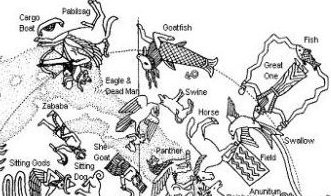Thus we have successfully coordinated the Julian dates with the star positions at the ancient time when Aldebaran rose with the Sun at 0h - i.e. 68 precessional days earlier than at the time of rongorongo and 68 - 27 = 41 precessional days earlier than at the time of Caesar. And since we began by coordinating the G text with the star time positions we have now also been able to coordinate the glyphs with the corresponding Julian dates. The Gregorian calendar was 'crooked' - not in agreement with the ancient traditional knowledge and not possible to use for representing the precessional machinery. ... When the Pope Gregory XIII updated the Julian calendar he did not revise what had gone wrong before 325 AD (when the Council of Nicaea was held). Thus the stars were were still 3-4 days 'out of tune' compared to the calendar ... ... he had moved spring equinox to a position which was 4 days too early compared to the ancient model. And he had also broken the Julian connection between the Sun year and the Sirius year. The Julian year was precisely as long as the Sirius year, but the new Gregorian year was slightly shorter - due to fewer leap days - and no longer was Sirius going to stand still in the calendar, no longer would Sirius be a marvellous star; only the brightest, which however was no mystery because there had to be some star which was brightest ... Finally we have also coordinated the glyphs in the G text with the dates of the Hawaaian Makahiki ceremonies, which evidently also were coordinated with the Julian calendar:
At the time of rongorongo heliacal Altair (α) had been pushed ahead by the precession to January 15, day 300 after 0h. 380 - 80 = *300 (= *232 + 68 = *273 + 27). Allen: "With β and γ it [α] constituted the ... nakshatra ăravan, the Ear, and probably was at first so drawn, although also known as ărona, Lame, or as Ašvattha, the Sacred Fig Tree, Vishnu being regent of the asterism; these stars representing the Three Footsteps with which that god strode through the heavens, a Trident being the symbol."
When you are sleeping only your kuhane (dream soul) moves about freely, whereas the evolution of the species has secured your body by making it lie quite still - as if bound or imprisoned.
Between the front side of your head (adorned with a pair of eyes) and its back side (covered up by hair) there is a pair of ears. They are positioned at dawn (right ear) respectively at the horizon in the west (left ear). When the daylight is insufficient the ears are good supporters for keeping you alive.
There is a left side ear depicted in Gb5-10 and the sign for the mouth below the midsummer Tree (Jupiter) has here been cleverly reused for the time a quarter earlier.
According to the Julian calendar the date was 'April 25, which serves as another confirmation supporting my interpretation of the text: ... Later on in this series of rituals, the Chorti go through a ceremony they call raising the sky. This ritual takes place at midnight on the twenty-fifth of April and continues each night until the rains arrive. In this ceremony two diviners and their wives sit on benches so that they occupy the corner positions of the cosmic square. They take their seats in the same order as the stones were placed, with the men on the eastern side and the women on the west. The ritual actions of sitting down and lifting upward are done with great precision and care, because they are directly related to the actions done by the gods at Creation. The people represent the gods of the four corners and the clouds that cover the earth. As they rise from their seats, they metaphorically lift the sky. If their lifting motion is uneven, the rains will be irregular and harmful ... |
|||||||||||||||||||||||||||||||||||||||||||||||||||||||||||||||||||||||||||||||||||||||||||||||||||||||||||||||||||












